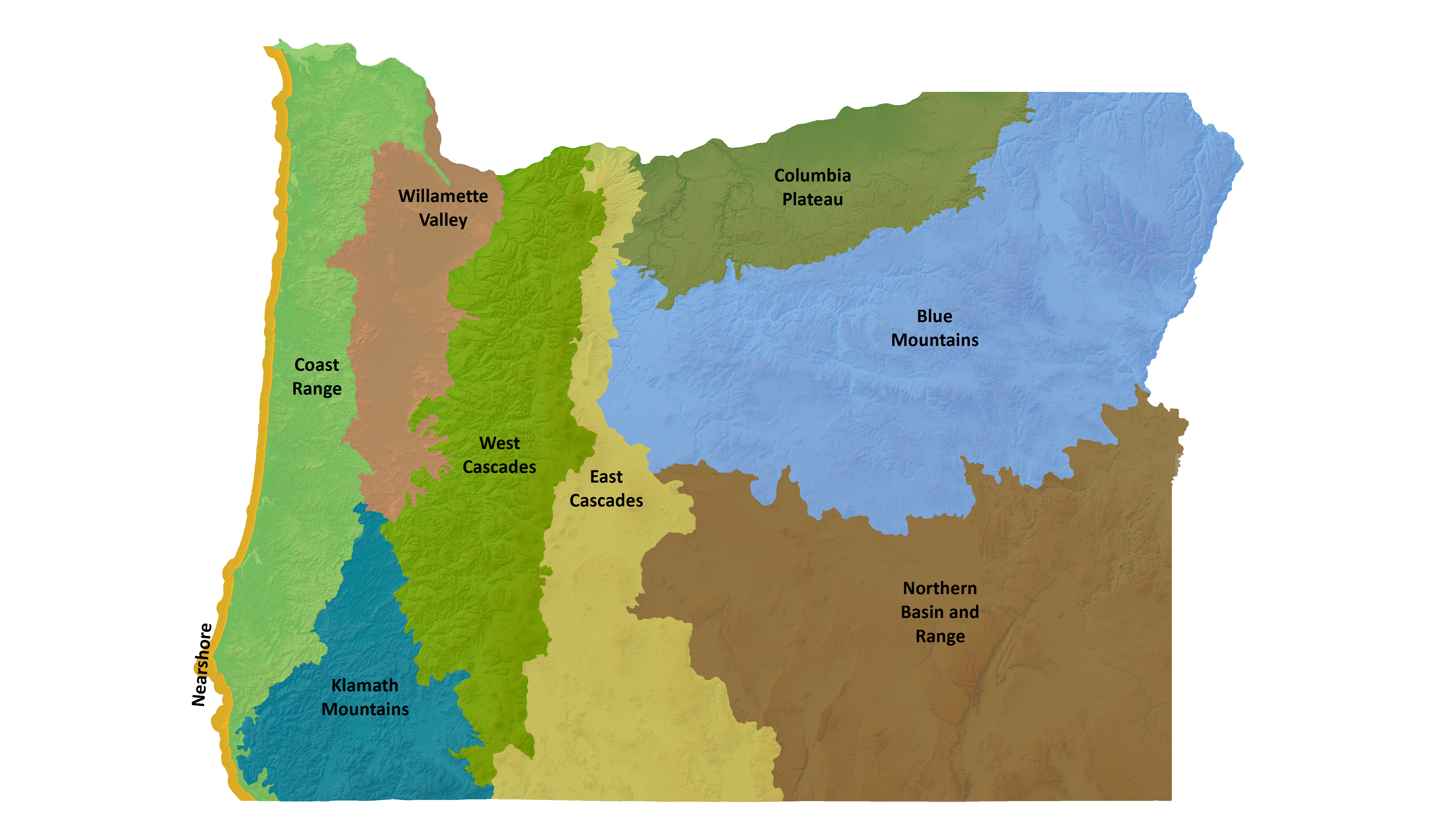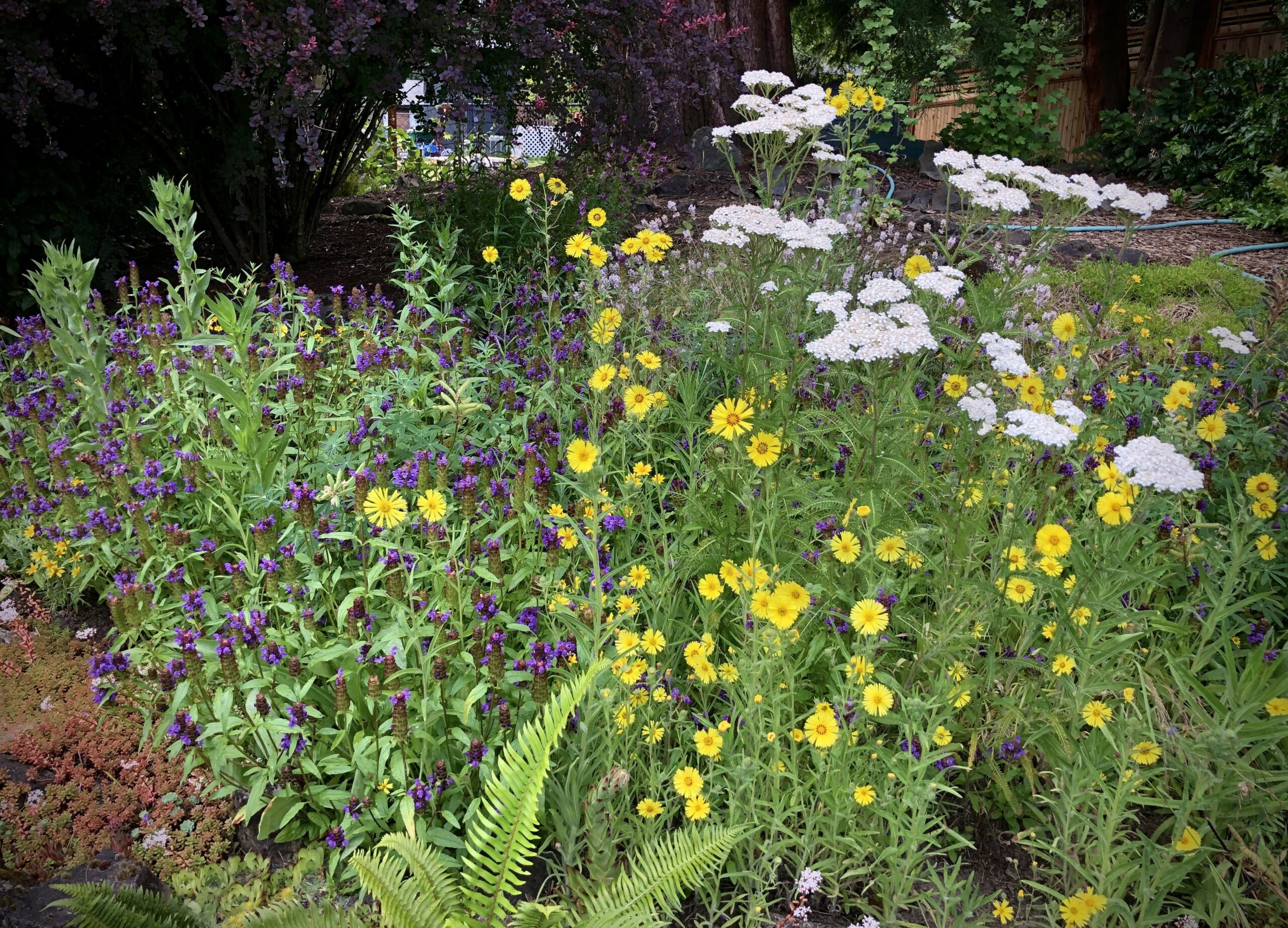Landscaping With Native Plants
Why Use Native Plants?
Have you ever walked through a meadow or other natural area and been impressed with the colorful array of native wildflowers? Do you enjoy watching birds, insects, and/or other wildlife use native plants for food, habitat, and raising their young? Are you interested in protecting or enhancing natural areas in your community? If you answered ‘yes’ to any of these questions, you may also be interested in incorporating native plants into your home yard/garden and/or helping restore local parks and natural areas with native plants.
Gardening with native plants offers many ecological, educational, and aesthetic benefits:
- Native plants are a beautiful part of our natural heritage. The Oregon State flower is Oregon grape (Berberis aquifolium) while the Native Plant Society of Oregon’s iconic symbol is western wakerobin (Trillium ovatum), both splendid examples of our native flora.
- Native plants attract insect pollinators, seed dispersers, and other native fauna, often providing critical food or habitat for our native wildlife. For example, many of our native butterflies depend on a single native plant species during their caterpillar stage. Monarch butterfly caterpillars depend on local native milkweed species (Asclepias sp.) while Blue butterfly caterpillars depend on lupines (Lupinus sp.) for their food source in order to develop into adult butterflies. Roemer’s fescue (Festuca roemeri) is a larval host plant for the rare Mardon Skipper butterfly, once a Candidate species for listing under the Endangered Species Act. One of the host plants for the Painted Lady Butterfly caterpillar is Oregon Sunshine (Eriophyllum lanatum) a native perennial plant that is easy to grow in a sunny garden spot. It is an important pollen and nectar source for many insect species.
- Native plants are adapted to local soil and climatic conditions, so most require minimal supplemental water and fertilizer, especially if you match your garden site with the habitat where they are found naturally. Thus, they can be easier to maintain than non-native ornamental plant species.
- Using native plants reduces the risk of introducing non-native invasive plants into our communities. For example, invasive weeds, such as orange hawkweed, yellow toadflax, oxeye daisy, and purple loosestrife, were introduced as garden plants.
- Growing native plants in your garden or backyard is a great way to gain familiarity with the plants and their identification as you watch them grow from seedlings into mature plants with flowers and finally into fruit. They can be beautiful in various stages throughout the season.
Planning for your native plant garden
The Native Plant Society of Oregon encourages you to grow Oregon native plants in your yard/garden. However, while there are hundreds of plants native to Oregon that make good garden plants, not all are necessarily native to your area of Oregon. When you are ready to select plants for your garden or landscaping project here are some planning recommendations:
- Contact your local NPSO chapter for information on native plants nurseries or other resources in your area and for recommendations on suitable plant species. Obtain plants and/or seed from respected nurseries, growers, or native plant sales, not from wild populations. Native plant sales are often sponsored by Conservation Districts, NPSO chapters, or non-profit organizations (e.g., Friends of Tryon Creek, Mt. Pisgah Arboretum). Local chapter members can also give advice on the best times of year to plant, and whether a particular species is better started from seed, a bulb or corm, a rooted cutting, or a nursery plant. Local chapter members may even be willing to give you seeds, starts, or plants or perhaps conduct a native plant swap or exchange!
- Use plants that are native to your ecoregion (e.g., the Willamette Valley, Coast Range, Columbia Plateau, Klamath Mountains, etc.). Ecoregions are areas that are relatively uniform in soils, vegetation, climate, geology, and wildlife. Plants growing naturally in your ecoregion are most likely to grow well in your garden. Nine major ecoregions are recognized in Oregon:
 Oregon Flora’s mapping application can help you learn what plants are native to your ecoregion and even more locally. By using native plants local to your ecoregion (or closer), local genotypes are preserved while avoiding the introduction of genetic material from other ecoregions which may not be as successful or may reduce the overall fitness of the more local genotypes.
Oregon Flora’s mapping application can help you learn what plants are native to your ecoregion and even more locally. By using native plants local to your ecoregion (or closer), local genotypes are preserved while avoiding the introduction of genetic material from other ecoregions which may not be as successful or may reduce the overall fitness of the more local genotypes. - Take notes while observing your yard/garden. Draw a map or diagram that shows the location of buildings, fences, paths, existing trees/shrubs, etc. Develop an understanding of slope, aspect, prevailing wind, sun and shade, soil moisture, etc. and how those environmental factors interact to create the micro-habitat conditions present in your yard/garden.
- Choose native plants that grow well in the particular micro-habitat conditions present in your yard/garden. For example, for moist, shady spots, select native plants that grow naturally in moist or riparian environments. It is good practice to observe the species you are interested in growing in its natural environmental setting. Find a natural area that has similar conditions as what is present in your home yard/garden or one that has plants that you are interested in growing. When you return to your home yard/garden, evaluate whether it provides a similar habitat and use this information to help select native plants accordingly.
- Except for salvage or rescue from imminent demise, NEVER dig whole plants from the wild. Gathering seeds and/or taking cuttings where it will not impact the native population is acceptable but ALWAYS check with the landowner/land manager and acquire any necessary permits before doing so. Refer to NPSO’s Ethical Guidelines for Collecting, Growing, and Displaying Native Plants for more information.
Advice when purchasing plants from growers and/or nurseries:
- Patronize growers and nurseries who exercise discretion and ethics in their collecting of seeds or cuttings or who acquire plants from other growers to avoid damaging native plant populations. Do not buy from growers and nurseries that dig plants from the wild. Native plant sold in nurseries should have been propagated from seeds or cuttings. Your local NPSO chapter may be able to recommend local growers and nurseries that use non-destructive practices as sources for native plant materials.
- Ask the grower or nursery where the geographic source of the material is. When possible, select seed and/or plants that originated nearest your home (i.e., plants that are locally native). Also, try to ascertain that plants have not been obtained from locations known to harbor harmful pathogens (i.e, do not purchase Oregon white oaks from locations infested with sudden oak death).
- Oregon Flora has interactive tools for identifying many commercially available native plant species as well as finding growers and/or nurseries for them. The tools detail around 300 native species and many growers and/or nurseries from around the state of Oregon.
- When shopping or purchasing native plants, select those that are healthy looking, with vigorous growth, good foliage color, and without insect damage or leaf spots indicative of a fungal, bacterial, or viral infection. If bringing residual pesticides into your yard/garden is a concern, there are nurseries available that do not use them.
- Take care that the soil in which purchased plants are growing is not contaminated with weeds. Monitor your garden for weeds that may germinate from seeds in the soil.
Advice for planting your native plants:
- Select planting locations and/or micro-habitat conditions in your yard/garden that are most suitable for the plants you have acquired.
- In our climate, expect most perennial native plants to do better when planted between fall and spring during their dormant season or prior to putting on significant vegetative growth. This allows their roots to get established before putting on significant foliage. Native species grown from seed often need cool (or cold) and moist conditions to break seed dormancy and stimulate germination. Many annual species may actually germinate in the fall then lie dormant through winter before taking off again in spring. Understanding the plants you selected and their establishment needs is crucial to their success.
- Prepare your ground before planting; adding compost and/or a bit of organic fertilizer to the soil around the roots can aid establishment. In arid regions, products that hold moisture can be placed around the roots.
- Most plants will need supplemental water during the first growing season; after that, over-watering is a common reason for native plants doing poorly. If a species naturally goes dormant in the dry part of the summer, let it! If you have matched your yard/garden conditions with that of the species’ native habitat, overwatering may only serve to assist the non-desirable species such as weeds!
Resources
Oregon Flora – Gardening with Natives
PlantNative – Introduction to Native Plant Landscaping
Gardening with Oregon Native Plants West of the Cascades
The Wild Garden – Gardening, Naturescaping & Landscaping with Pacific Northwest Native Plants
Metro – Native Plants for Willamette Valley Yards
Clean Water Services – Tualatin Valley Native Plants
Backyard Habitat Certification Program
Native Plants PNW – An Encyclopedia of the Cultural and Natural History of Northwest Native Plants
High Desert Horticultural Center
An Introduction to Xeriscaping in the High Desert
Water-wise Gardening in Central Oregon

